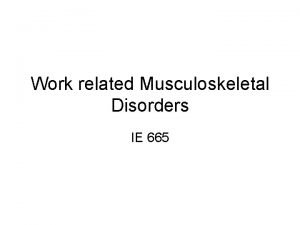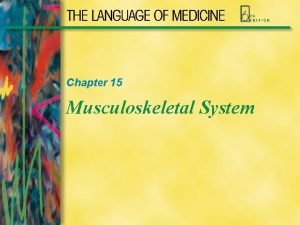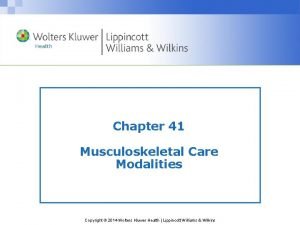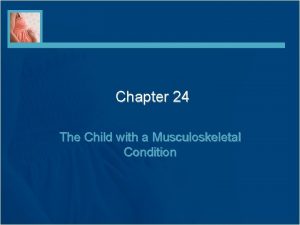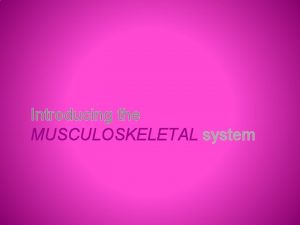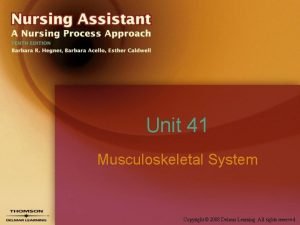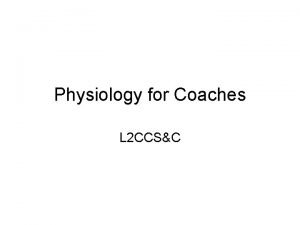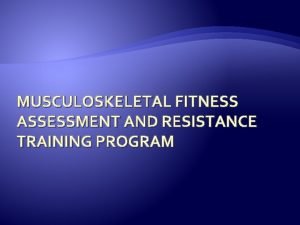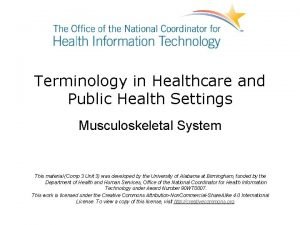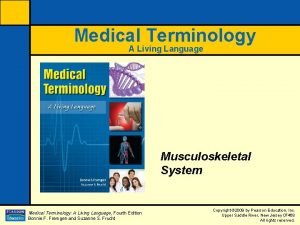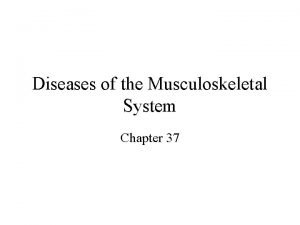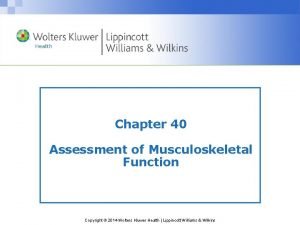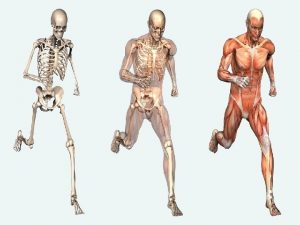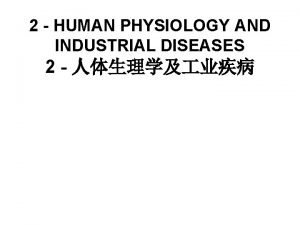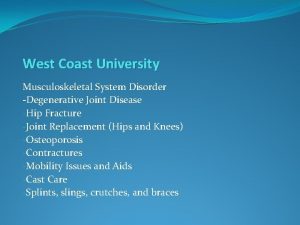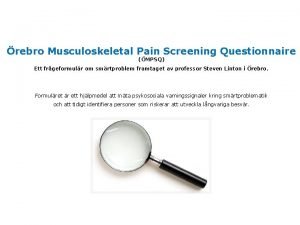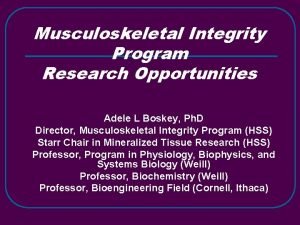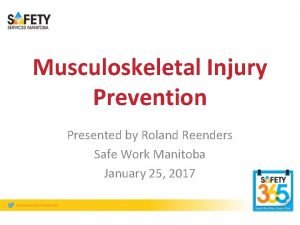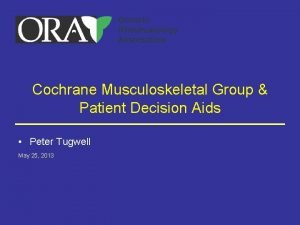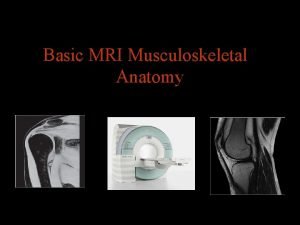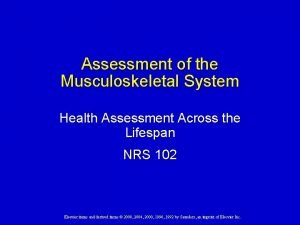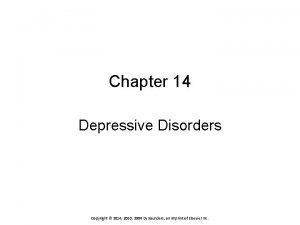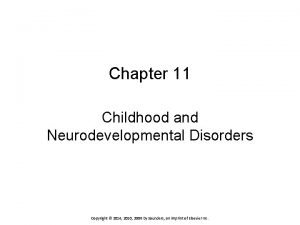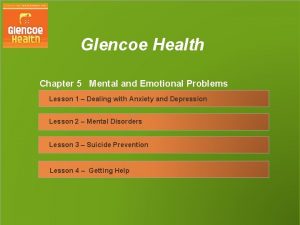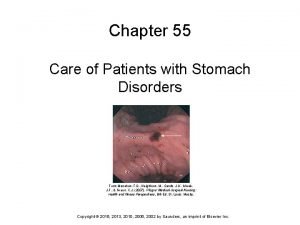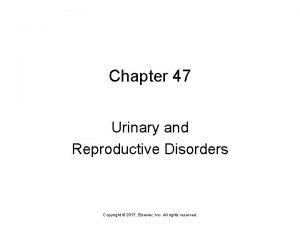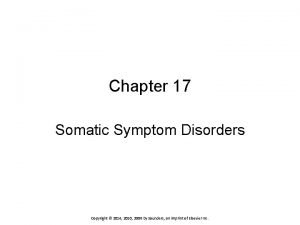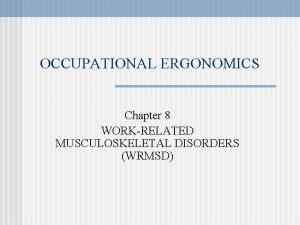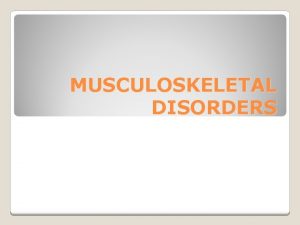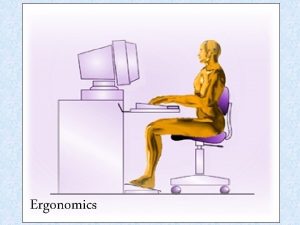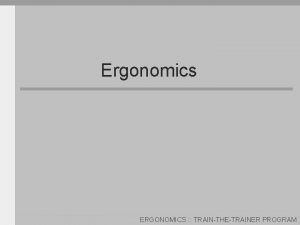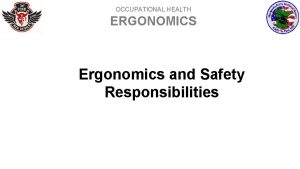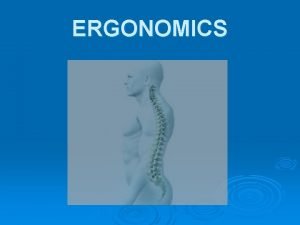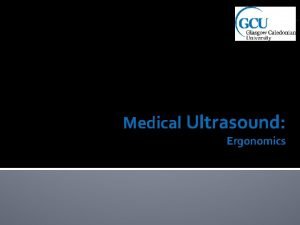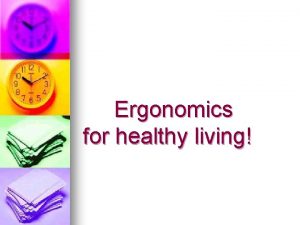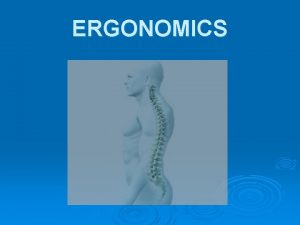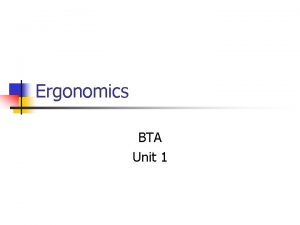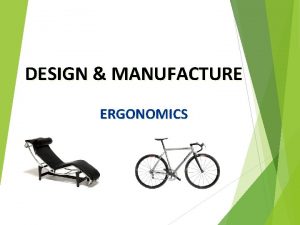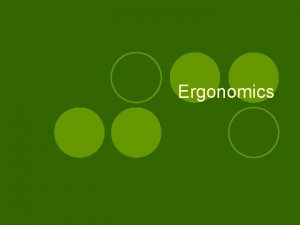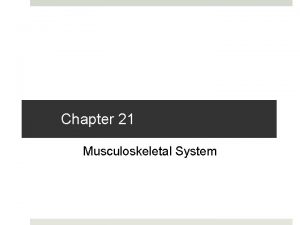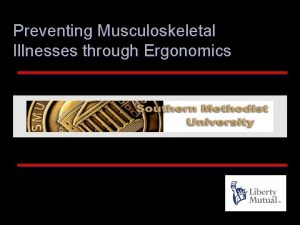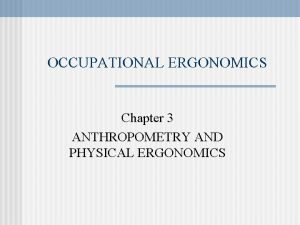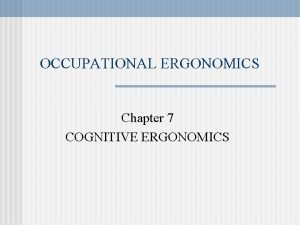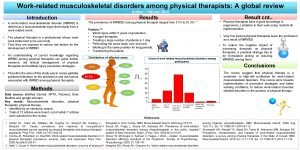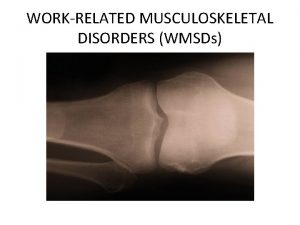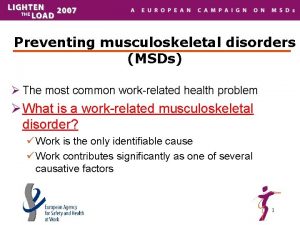OCCUPATIONAL ERGONOMICS Chapter 8 WORKRELATED MUSCULOSKELETAL DISORDERS WRMSD










































![WORK-RELATED MUSCULOSKELETAL DISORDERS RWL = [LC*HM*VM*DM*AM*FM*CM] where, RWL = Recommended weight limit LC = WORK-RELATED MUSCULOSKELETAL DISORDERS RWL = [LC*HM*VM*DM*AM*FM*CM] where, RWL = Recommended weight limit LC =](https://slidetodoc.com/presentation_image/4f0467ff7d0a2df762fb5edb355b2704/image-43.jpg)















- Slides: 58

OCCUPATIONAL ERGONOMICS Chapter 8 WORK-RELATED MUSCULOSKELETAL DISORDERS (WRMSD)

WORK-RELATED MUSCULOSKELETAL DISORDERS Learning Objectives At the conclusion of this chapter, learners will be able to do the following: n n Demonstrate knowledge of the different types of WRMSDs Demonstrate knowledge of the risk factors of different types of WRMSDs Understand the variable and limitations of NIOSH lifting model Evaluate the risk of upper extremity WRMSDs 2

WORK-RELATED MUSCULOSKELETAL DISORDERS Introduction The World Health Organization has characterized “workrelated” diseases as multifactorial to indicate that a number of risk factors (e. g. , physical, work organizational, psychosocial, individual, and sociocultural) contribute to causing these diseases [WHO, 1985]. WRMSD of the low back can be related to Manual material handling (MMH) while WRMSD of the upper and lower extremities may be MMH or occupational based. 3

WORK-RELATED MUSCULOSKELETAL DISORDERS Definition of WRMSD Physical injuries that develop gradually over a period of time as a result of repeated biomechanical and physiological stresses on a specific body part. 4

WORK-RELATED MUSCULOSKELETAL DISORDERS Terms synonymous with WRMSD Cumulative trauma disorders (CTDs) Repetitive motion injuries (RMIs) Chronic trauma disorders Repetitive strain injuries (RSIs) Repetitive trauma disorders Wear and tear disorders Overuse Syndrome Occupational cerviobrachial disorders Repeated trauma illnesses (RTIs) 5

WORK-RELATED MUSCULOSKELETAL DISORDERS MMH activities include the following: Lifting Lowering Pushing Pulling Holding Carrying 6

WORK-RELATED MUSCULOSKELETAL DISORDERS Industrial engineering professionals seek to minimize any form of materials handling in work systems. This is Because materials handling is a non-value adding activity. In 2004 the top 10 causes of serious workplace injuries accounted for 88. 1% of the total cost of the workplace injuries with the top 3 causes accounting for $25 billion (Liberty Mutual, 2004). The top 10 cited include overexertion, falls on same level, bodily reaction, falls to lower level, struck by object, highway incidents, repetitive motion, struck against object, caught in or compressed by equipment, and assaults and violent acts. 7

WORK-RELATED MUSCULOSKELETAL DISORDERS The classification of results in this review by body part and specific risk factor are summarized by NIOSH 1997 -141 in Table 8. 1. 8

WORK-RELATED MUSCULOSKELETAL DISORDERS Types of CTD 1. Tendon disorders: ‑ Tendinitis ‑ Tenosynovitis ‑ Bursitis - Ganglionic cyst - Trigger fingers - De Quervain's disease 9

10

11

WORK-RELATED MUSCULOSKELETAL DISORDERS 2. Neurovascular disorders: ‑ Thoracic Outlet Syndrome - Vibration Syndrome 3. Nerve Entrapment Disorders ‑ Carpal Tunnel Syndrome ‑ Guyon Tunnel Syndrome - Cubital Tunnel Syndrome 12

WORK-RELATED MUSCULOSKELETAL DISORDERS Carpal Tunnel Syndrome (CTS) CTS is generally attributed to compression of the median nerve as it passes through the carpal tunnel. 13

14

15

WORK-RELATED MUSCULOSKELETAL DISORDERS Symptoms of CTS - Weakness, pain, burning, numbness or tingling in hands and wrists a. often at night or at rest b. in severe cases pain may spread as far as the shoulder - Thenar atrophy - Reduced grip strength and range of motion 16

WORK-RELATED MUSCULOSKELETAL DISORDERS Occupational risk factors for WRMSD 1. Awkward postures 2. Excessive manual force 3. High repetition or frequency 4. Extended task duration/ inadequate rest 17

WORK-RELATED MUSCULOSKELETAL DISORDERS Risk factors for CTS A number of risk factors have been associated with the development of CTS. These risk factors can be divided into three broad categories: 1) systemic conditions; 2) non‑occupational risk factors; and 3) occupational risk factors (Turner and Buckle, 1987). 18

WORK-RELATED MUSCULOSKELETAL DISORDERS Systemic conditions may account for about 20‑ 30% of the total number of CTS sufferers. Some of these conditions include the following: 1. Acromegaly ‑ this is an endocrine disorder in which ongoing pituitary overactivity appears to be related to the appearance of CTS. 2. Amyloidosis ‑ deposits of amyloid have been found in the carpal tunnel of patients with this disorder. 3. Diabetes Mellitus ‑ it has been reported that approximately 5‑ 16% of certain groups of CTS patients appear to be diabetics. 4. Hyperparathyroidism ‑ primary and secondary (resulting from renal dysfunction) hyperparathyroidism have been associated with the development of CTS. 19

WORK-RELATED MUSCULOSKELETAL DISORDERS 5. Hypothyroidism and Myoedema ‑ this is an endocrine disorder that has been associated with CTS. 6. Renal failure ‑ altered hemodynamics resulting from dialysis procedures may be related to CTS development. 7. Rheumatoid arthritis ‑ it has been reported that approximately 7‑ 11 % of CTS patients suffer from this disorder. 20

WORK-RELATED MUSCULOSKELETAL DISORDERS Work-related risk factors for CTS Awkward posture of the wrist Excessive manual force applied to the wrist High repetition or frequency - keystrokes Up to 25, 000 per day, no problems Above 80, 000 per day, may be problematic Typical rates = 10, 000 to 12, 000 per/Hr Extended task duration Vibration of equipment Cold temperatures Use of the pinch grip 21

WORK-RELATED MUSCULOSKELETAL DISORDERS Non‑occupational risk factors for CTS Age Gender Gynecological surgery Menopause Pregnancy Premenstrual Syndrome (PMS) Family history Trauma and medication Vitamin B 6 deficiency Hobbies 22

WORK-RELATED MUSCULOSKELETAL DISORDERS Typical Treatment Strategies - Conservative treatments (rest, heat/cold compress, wrist splints) - Medication (anti-inflammatory, steroids) - Surgical release Diagnosis of CTS - Tinel's sign ‑ Phalen's test ‑ Nerve impulse conduction velocity 23

24

WORK-RELATED MUSCULOSKELETAL DISORDERS Job identified disorder, and occupational risk factors are provided in Table 8. 2 (Putz-Anderson, 1988) 25

WORK-RELATED MUSCULOSKELETAL DISORDERS Abatement of WRMSD for Upper Extremities Repetitious: Cycle time less than 30 seconds OR 50% (or more) of total cycle time performing same fundamental task element. Forceful: Hand forces exceeding 10 lbs (4. 5 kg). For continuous, repetitive tasks, build in fiveminute rest break per hour 26

WORK-RELATED MUSCULOSKELETAL DISORDERS Guidelines for reducing upperextremity WRMSDs (contd. ) - Limit force requirements to less than 20% of the maximum isometric strength for that particular operation. For the 5% female, assume the following 20% limits: 2. 25 lbs for pinching forces 11. 4 lbs for grasp forces - Avoid repetitive operations requiring the spread between the thumb and fingers more than 2. 5 inches 27

WORK-RELATED MUSCULOSKELETAL DISORDERS Guidelines for reducing upper extremity WRMSDs (contd. ) - Avoid or minimize use of tools with vibration * vibrating tools will require a greater grasp force to manipulate * can also lead to development of vibration syndromes - Avoid using hands as "holding fixtures" 28

WORK-RELATED MUSCULOSKELETAL DISORDERS WRMSD Risk Assessment Body. Map Instrument Simplified Ergonomic Checklist 29

30

31

32

WORK-RELATED MUSCULOSKELETAL DISORDERS Types of lower-extremity WRMSDs Some typical lower-extremity WRMSDs are as follows: n Knee disorders • • n n Jumper’s knee (patellar tendonitis) Chondromalacia Lower leg Shin splints Foot disorders • • Plantar fasciitis Tarsal tunnel syndrome The risk factors for lower-extremity WRMSDs include forceful exertions, repetition, awkward posture, vibration, and duration. 33

WORK-RELATED MUSCULOSKELETAL DISORDERS n Research work in the area of lower extremities is rather scarce. NIOSH study with carpet layers says that they make up less than 0. 06% of the U. S. workforce but they file 6. 2% of all workers' compensation claims for traumatic knee injury--a rate that is 108 times that expected in the total workforce and the highest rate of any occupation reporting such claims [Tanaka et al. 1982]. Tilesetters (53 times that expected) and floorlayers (46 times that expected), both of whom perform work that requires kneeling on hard floors. Carpet layers share this risk factor, but they also use the knee kicker to stretch carpet for wall-to-wall installation (NIOSH, 1990). 34

WORK-RELATED MUSCULOSKELETAL DISORDERS NIOSH (1990 -104) recommends the following measures to prevent or reduce knee disorders among carpet layers: n All concerned should educate them about the hazards of kneeling and using the knee kicker, and encourage carpet layers to wear knee pads and to use the power stretcher. n Carpet layers should always wear protective knee pads while working directly on hard floor surfaces. n Employers should provide an adequate number of power stretchers for each work crew. 35

WORK-RELATED MUSCULOSKELETAL DISORDERS n n Carpet layers should be trained to use the power stretcher proficiently in rooms of any size. Use of the knee kicker should be prohibited for stretching the carpet where strong kicks are required. The portability of the power stretcher should be improved by engineering approaches (attaching casters to the carrying case, for example). Research should be conducted to develop carpet installation methods that further reduce the physical stress and trauma suffered by carpet layers. 36

WORK-RELATED MUSCULOSKELETAL DISORDERS Low-back Disorders Some occupational risk factors for lifting 1. Starting vertical height of lift 2. Ending vertical height of lift 3. Starting horizontal position of lift 4. Ending horizontal position of lift 5. Frequency of lifting 6. Degree of twisting 7. Duration of shift 8. Type of handles or coupling 9. Weight of load 37

WORK-RELATED MUSCULOSKELETAL DISORDERS NIOSH LIFTING GUIDELINES The 1981 model made use of Action Limit (AL) and Maximum Permissible Limit (MPL) concepts. Determination of AL based upon: Epidemiological data: that some workers at risk at high AL Biomechanical models: 3400 N (770 lbs) of compression on L 5/S 1 (AL value) tolerated by most workers. Physiological studies: that work at AL would yield 3. 5 kcal per min. requirement, which is acceptable to most workers. Psychophysical studies: that 75% of women and 99% of men could lift AL comfortably. 38

WORK-RELATED MUSCULOSKELETAL DISORDERS Determination of MPL based upon: Injury and severity rate is significantly higher for most workers when MPL exceeded. Biomechanical models show that most workers cannot tolerate 6400 N (1430 lbs) at L 5/S 1 generated at MPL. Physiological studies indicate that energy demand for frequent lifting at MPL exceed 5 kcal/min. and is not tolerable for most workers. Psychophysical data indicate that 25% of men and less than 1% of women can lift above MPL. 39

WORK-RELATED MUSCULOSKELETAL DISORDERS Based on the above, the following guideline was established: Load < AL (acceptable) AL < Load < MPL (unacceptable--administrative controls required) MPL < Load (unacceptable--engineering controls required) 40

41

WORK-RELATED MUSCULOSKELETAL DISORDERS Revised NIOSH 1991 Model LI = Load Weight Recommended Weight Limit = L RWL LI = Lifting Index RWL = Recommended Weight Limit When LI value exceeds 1. 0, then an increase in lifting hazard exists for the working population. An LI exceeding 3. 0 represents a significant risk of personal injury for a majority of the working population. Thus, LI values <= 1. 0 are considered acceptable for most workers and values => 3. 0 are considered unacceptable for most workers. 42
![WORKRELATED MUSCULOSKELETAL DISORDERS RWL LCHMVMDMAMFMCM where RWL Recommended weight limit LC WORK-RELATED MUSCULOSKELETAL DISORDERS RWL = [LC*HM*VM*DM*AM*FM*CM] where, RWL = Recommended weight limit LC =](https://slidetodoc.com/presentation_image/4f0467ff7d0a2df762fb5edb355b2704/image-43.jpg)
WORK-RELATED MUSCULOSKELETAL DISORDERS RWL = [LC*HM*VM*DM*AM*FM*CM] where, RWL = Recommended weight limit LC = Load constant HM = Horizontal multiplier VM = Vertical multiplier DM = Distance multiplier AM = Asymmetric multiplier FM = Frequency multiplier CM = Coupling multiplier 43

44

45

46

47

48

49

50

WORK-RELATED MUSCULOSKELETAL DISORDERS Controls for Low-back Risk – NIOSH’s strategies Engineering Controls Container design As small as possible to min. comp. Forces at L 5/S 1 disc Baffles, dividers to keep CG at a constant location Safe method of lifting will determine critical dimensions Place handles above the CG Human/container coupling design Handles should match user’s hands Appropriate hand clearance, handle dia. and smooth surface 51

WORK-RELATED MUSCULOSKELETAL DISORDERS Human/container coupling design (contd. ) Based on types of grip (hook, power, and precision), hand postures should be maintained Worker/floor surface coupling Take care of possibilities of slips, trips, and mis-steps Take appropriate measures to increase coefficient of friction between shoe sole and working surface Recommended value for coefficient of friction 0. 4 -0. 5 Administrative Controls Selection of workers Include physical assessment or test 52

WORK-RELATED MUSCULOSKELETAL DISORDERS This test must be: safe to administer, reliable, related to specific job reqt. , practical, and able to predict risk of future injury or illness. Training of workers Training should be aimed at making the workers aware of the dangers of careless and unskilled MMH, showing the workers the methods to avoid unnecessary stress, and teaching them to be aware of safe handling practices 53

WORK-RELATED MUSCULOSKELETAL DISORDERS Back Supports Major findings of NIOSH • • • They do not reduce injury rate May give a false sense of security They do not reduce forces on the spine They do not necessarily remind workers to lift properly They may decrease bending motion of the spine They may stiffen the spine They tend to increase blood pressure, which could be a problem for older workers or hypertensive workers. 54

WORK-RELATED MUSCULOSKELETAL DISORDERS Other Control Methodologies Eliminate the need for MMH Use mechanical aids Change work area layout Decrease job demands Decrease weight Change type of MMH activity Change work area layout Maximize time to perform job 55

WORK-RELATED MUSCULOSKELETAL DISORDERS Other Control Methodologies (contd. ) Minimize Stressful Body Movement Reduce bending motions Reduce twisting motions Allow safe lifting to occur 56

57

58
 Chapter 6 musculoskeletal system diseases and disorders
Chapter 6 musculoskeletal system diseases and disorders Wrmsd
Wrmsd Work related musculoskeletal disorders definition
Work related musculoskeletal disorders definition Chapter 21 the musculoskeletal system
Chapter 21 the musculoskeletal system Chapter 15 musculoskeletal system
Chapter 15 musculoskeletal system Chapter 41 musculoskeletal care modalities
Chapter 41 musculoskeletal care modalities Buck's extension traction
Buck's extension traction Musculoskeletal system
Musculoskeletal system Unit 41 musculoskeletal system
Unit 41 musculoskeletal system Musculoskeletal system
Musculoskeletal system Contoh soal koding icd 10
Contoh soal koding icd 10 Kode icd 10 gout arthritis
Kode icd 10 gout arthritis Musculoskeletal fitness assessment
Musculoskeletal fitness assessment Musculoskeletal pronounce
Musculoskeletal pronounce Inversion medical terminology
Inversion medical terminology Diseases of the musculoskeletal system
Diseases of the musculoskeletal system Assessment of the musculoskeletal system
Assessment of the musculoskeletal system Assessment of the musculoskeletal system
Assessment of the musculoskeletal system Musculoskeletal system
Musculoskeletal system West coast musculoskeletal
West coast musculoskeletal Mpsq
Mpsq Musculoskeletal
Musculoskeletal Musculoskeletal integrity
Musculoskeletal integrity Thank you pictures for presentation
Thank you pictures for presentation Musculoskeletal
Musculoskeletal Musculoskeletal
Musculoskeletal Musculoskeletal surgery ayr
Musculoskeletal surgery ayr Cochrane musculoskeletal group
Cochrane musculoskeletal group Mri
Mri Objective data for musculoskeletal system
Objective data for musculoskeletal system Chapter 18 psychological disorders
Chapter 18 psychological disorders Chorionic villus
Chorionic villus Chapter 8 skin disorders and diseases
Chapter 8 skin disorders and diseases Chapter 46 digestive and endocrine disorders
Chapter 46 digestive and endocrine disorders Types of somatic disorder
Types of somatic disorder Chapter 29 endocrine and metabolic disorders
Chapter 29 endocrine and metabolic disorders Chapter 21 mental health diseases and disorders
Chapter 21 mental health diseases and disorders Chapter 18 psychological disorders
Chapter 18 psychological disorders Chapter 18 eating and feeding disorders
Chapter 18 eating and feeding disorders Chapter 17 reproductive system diseases and disorders
Chapter 17 reproductive system diseases and disorders Chapter 15 nervous system diseases and disorders
Chapter 15 nervous system diseases and disorders Chapter 15 anxiety and obsessive-compulsive disorders
Chapter 15 anxiety and obsessive-compulsive disorders Chapter 14 psychological disorders
Chapter 14 psychological disorders Chapter 14 depressive disorders
Chapter 14 depressive disorders Chapter 11 childhood and neurodevelopmental disorders
Chapter 11 childhood and neurodevelopmental disorders Chapter 5 glencoe health answers
Chapter 5 glencoe health answers Seborrheic keratoses
Seborrheic keratoses Chapter 5 lesson 2 mental disorders
Chapter 5 lesson 2 mental disorders Chapter 10 nail disorders and diseases
Chapter 10 nail disorders and diseases Milady chapter 10
Milady chapter 10 Chapter 8 cardiovascular system
Chapter 8 cardiovascular system Milady chapter 8 skin disorders and diseases
Milady chapter 8 skin disorders and diseases Chapter 14 psychological disorders
Chapter 14 psychological disorders Ap psychology chapter 15
Ap psychology chapter 15 Chapter 55 care of patients with stomach disorders
Chapter 55 care of patients with stomach disorders Chapter 47 urinary and reproductive disorders
Chapter 47 urinary and reproductive disorders Chapter 17 somatic symptom disorders
Chapter 17 somatic symptom disorders Chapter 12 schizophrenia spectrum disorders
Chapter 12 schizophrenia spectrum disorders Chapter 11 lesson 1 maintaining a healthy weight
Chapter 11 lesson 1 maintaining a healthy weight


